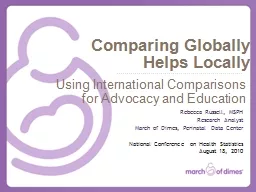PPT-Comparing Globally Helps Locally
Author : briana-ranney | Published Date : 2016-03-22
Using International Comparisons for Advocacy and Education Rebecca Russell MSPH Research Analyst March of Dimes Perinatal Data Center National Conference on Health
Presentation Embed Code
Download Presentation
Download Presentation The PPT/PDF document "Comparing Globally Helps Locally" is the property of its rightful owner. Permission is granted to download and print the materials on this website for personal, non-commercial use only, and to display it on your personal computer provided you do not modify the materials and that you retain all copyright notices contained in the materials. By downloading content from our website, you accept the terms of this agreement.
Comparing Globally Helps Locally: Transcript
Download Rules Of Document
"Comparing Globally Helps Locally"The content belongs to its owner. You may download and print it for personal use, without modification, and keep all copyright notices. By downloading, you agree to these terms.
Related Documents














